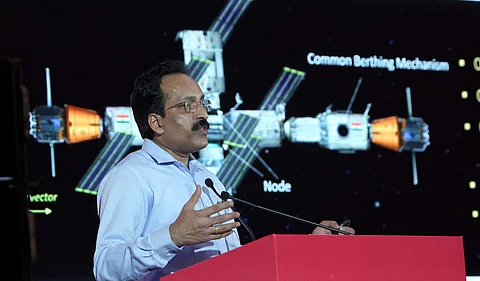

ISRO Chairman S. Somanath recently addressed an interesting question at Huddle Global 2024, India's beach startup summit, about the potential for satellite communication to solve connectivity issues in remote areas of Kerala, where traditional cell towers often fail. He shared insights on how advancements in satellite technology could transform telecommunications, highlighting the growing momentum toward direct satellite-to-mobile communication.
Mr Somanath mentioned that global efforts are already underway to make satellite-based mobile communication a reality. Companies like AST SpaceMobile, OneWeb, and SpaceX's Starlink have made significant progress. Starlink, founded by Elon Musk, is already demonstrating satellite-based internet services, with future launches planned for broader mobile connectivity.
A key concept discussed was "virtual towers in space," enabled by large satellite constellations operating at medium Earth orbit (MEO). This technology could potentially replace traditional mobile towers, offering direct mobile communication by bypassing terrestrial infrastructure. However, challenges remain in terms of cost, device compatibility, latency, and regulatory frameworks. The cost of building and maintaining such constellations is higher than that of traditional telecom systems, which may impact consumer affordability.
In the meantime, India has made strides in the satellite communications space, with Bharat Sanchar Nigam Limited (BSNL) launching its own satellite-to-device connectivity service. Unveiled at the India Mobile Congress in October, this service is a significant step toward providing reliable connectivity in areas where traditional cellular networks fail, such as remote mountainous regions or areas with little-to-no cellular coverage. BSNL's service leverages Low Earth Orbit (LEO) satellites to enable smartphone users to send text messages and make calls, even in locations where conventional mobile towers are absent.
This satellite-to-device service operates on select smartphones, including the latest iPhones and Google Pixel models, which already have built-in frameworks for satellite communication. BSNL has partnered with California-based Viasat to use its LEO satellites, ensuring uninterrupted connectivity in hard-to-reach areas like the trekking regions of Himachal Pradesh and Uttarakhand, the remote villages of Northeast India, and even desert regions near Rajasthan.
For telecom companies, the shift to satellite technology could disrupt their business models. However, partnerships with satellite operators may present new opportunities, as demonstrated by OneWeb's collaboration with telecom firms like Bharti.
While satellite-based communication is promising, Mr Somanath speculated that it could take a few years for this technology to become widely adopted, making it unlikely that mobile towers will be replaced anytime soon. The path to this future is still being paved, but the transformation of telecommunications is clearly on the horizon.